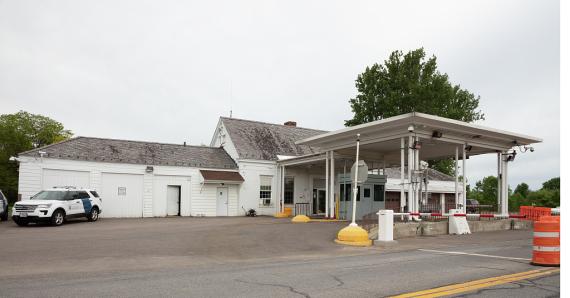Location: 101-133 Dundee Rd, Fort Covington, NY 12937
Significance
The Fort Covington Border Inspection Station in Fort Covington, New York is one of seven existing border inspection stations built between 1931 and 1934 along the New York and Canadian border. Colonial Revival in style, the building was designed by Louis A. Simon, Superintending Architect of the Architectural Division of the Treasury, and constructed in 1933 during the tenure of William H. Woodin, Secretary of the Treasury, Lawrence W. Robert, Jr., Assistant, and James A Wetmore, Acting Supervising Architect. Border stations were constructed by the federal government in several New England states along the border with Canada during the 1930s and several common plans and elevations can be discerned among the remaining stations. Fort Covington shares with the others a residential scale, a Neo-colonial style, and an organization to accommodate functions of both customs and immigration services.
Border Stations are associated with four important events in United States history: the imposition of Prohibition between 1919 and 1933; enactment of the Elliot-Fernald public buildings act in 1926 which was followed closely by the Depression; and the popularity of the automobile whose price was increasingly affordable thanks to Henry Ford’s creation of the industrial assembly line. The stations were constructed as part of the government’s program to improve its public buildings and to control casual smuggling of alcohol which most often took place in cars crossing the border. Their construction was also seen as a means of giving work to the many locally unemployed.
The Fort Covington border inspection station is an example of the more modest, rural version of the border stations also found at Chateaugay, Champlain, Rouses Point (Overtons Corner) and Mooers, New York. While the stations have all sustained systematic alterations, they have retained, in varying degrees, most of their original fabric. This station is in both exterior and interior a good example of the building type, but of the five similar stations, it has been altered the most. It is the only station to control a border over both land and water. Drawings indicate that it was planned to have two inspection residences at the site, although none remains today.
History
The era of Prohibition begun in 1919 with the Volstead Act and extended nationwide by the ratification of the Eighteenth Amendment in 1920, resulted in massive bootlegging along the Canadian border. In New York, early efforts to control bootlegging were carried out by a small number of Customs officers and border patrol officers who were often on foot and horseback. In many cases New York Custom Houses were a mile or so south of the border and travelers were expected to stop in and report their purchases. The opportunity to remedy this situation and support enforcement of the Prohibition laws was offered by enactment of the Elliot-Fernald public buildings act of 1926 which authorized the governments through the Treasury Department to accelerate its building program and began its allocation with $150,000,000 which it later increased considerably.
Fort Covington was west of the so-called Rum Trail which made Rouses Point the chief point of entry for bootlegged liquor in upstate New York, but it was a necessary border station for control. At the time Prohibition was repealed, the Fort Covington border inspection station had just been completed. However, the end of Prohibition did not mean the end of smuggling, as the public had developed a taste for Canadian liquor and its bootleggers had discovered the money that could be made smuggling raw alcohol into Canada where prices for it were considerably higher. Fort Covington continued to operate to interdict this activity.
While the seven New York border inspection stations had been designated for construction as early as 1929, land acquisition and the designing and bidding process was stalled at various stages for each of the buildings and their construction took place unevenly over a period of five years. Fort Covington was constructed among the last of the stations.
Building Facts
- Architect: Simon, Louis A.
- Construction Date: 1932
- GSA Building Number: NY0059ZZ
- Landmark Status: Listed in the National Register of Historic Places

 U.S. General Services Administration
U.S. General Services Administration
